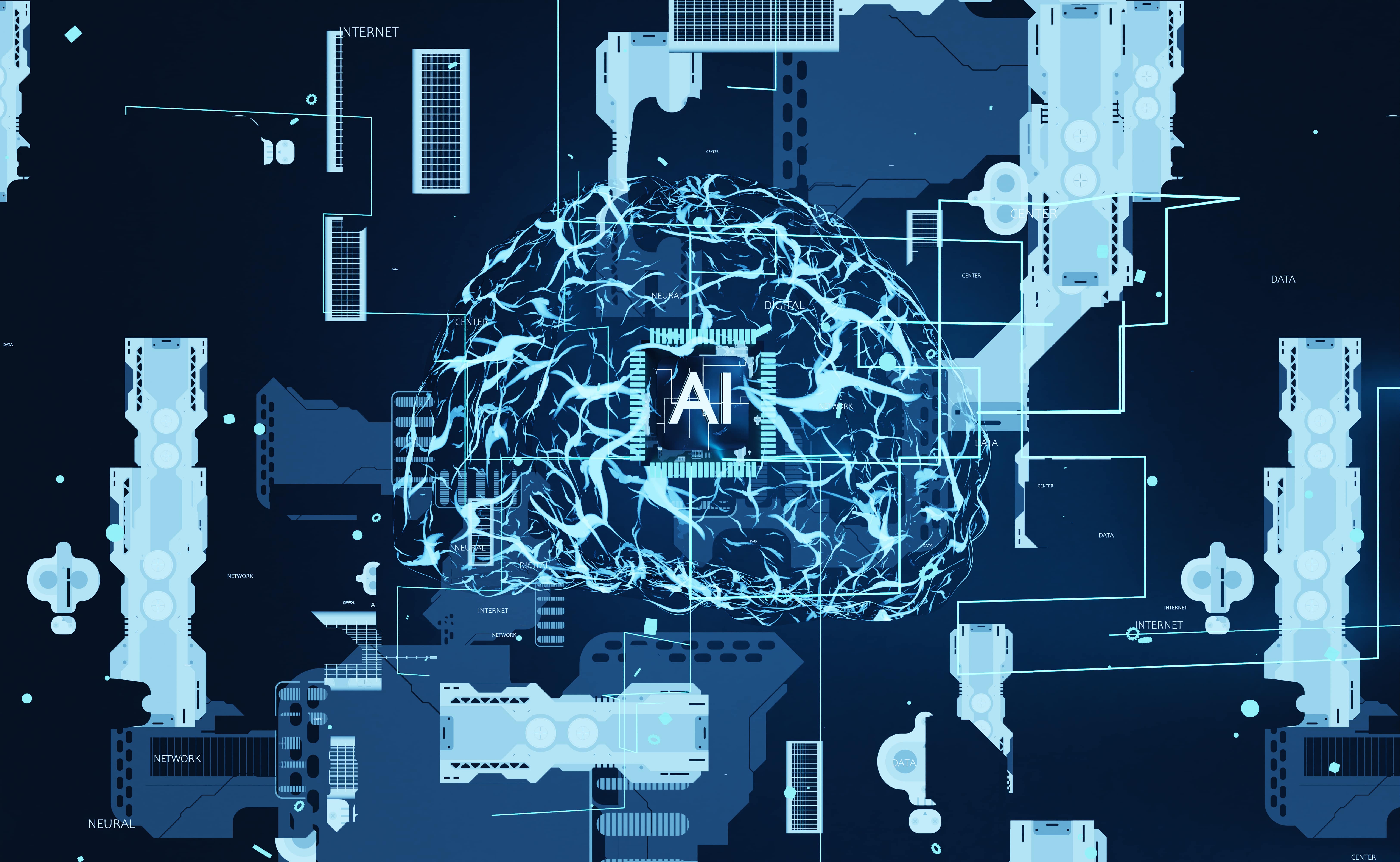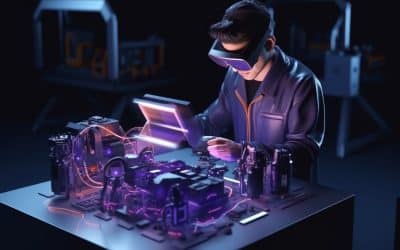Intelligent Automation (IA is a sophisticated technological method that transcends traditional tasks based on rules by using artificial intelligence (AI), machine learning (ML), and cognitive technologies. The process transforms businesses into self-contained systems capable of adapting, learning, and making effective decisions independently. IA integrates robot process automation (RPA) along with other technologies. It includes process mining optical character recognition (OCR)/intelligent character recognition (ICR), advanced analytics and neural language processing (NLP), and AI. As a result increasing efficiency and reducing operational risks.
Generative AI Integration Services also improves the customer experience by streamlining processes from end to end. It also enhances workflows and accelerates business transformation in various sectors. IA is a new age of digital technology that automates routine processes and enables businesses to utilize real-time, unstructured data to increase productivity and revenue growth.
Difference Between AI And Automation
Artificial intelligence refers to developing and producing digital computers and computer software, which would need human expertise in speech recognition, translation of language decisions, and the ability to perceive images. A computer is believed to be intelligent if it can perform tasks typically associated with humans. Artificial Intelligence is a broad-based technology that allows businesses to change the way they gather and use data and benefit from insight into decision-making. It employs robust databases and computer science methods to address challenges. It also includes subfields like machine learning and deep learning.
The current examples of artificial intelligence are intelligent assistants such as Siri and Alexa Robo-advisors, spam filters for email, intelligent automobiles, Netflix recommendations, and chatbots. However, intelligent automation refers to a mix of robot process automation (RPA) and business process management. It incorporates the latest technologies, such as ML, AI, Intelligent character recognition (ICR), optical character recognition (OCR), and analytics, to create an end-to-end process that can think, learn, and change without involvement. Intelligent automation can also be called hyper-automation or intelligent procedure automation (IPA).
Companies use intelligent automation to simplify decisions and improve efficiency, consequently speeding up the digital transformation. Intelligent automation can be used in various applications, helping free up resources, improving the efficiency of operational processes, and making complex tasks easier to manage.
The Benefits Of Generative AI Business Automation
The implementation of IA provides multiple advantages to companies:
- Generative AI Integration and automation offers significant cost savings by increasing employee employment and improving efficiency.
- By automatizing processes and systems, IA speeds up production processes while preserving precision and accuracy, ultimately resulting in higher ROI on the investment.
- IA enhances operational accuracy by ensuring process consistency, reducing the risk of mistakes, and improving output quality.
- Through simplifying processes, IA enhances customer satisfaction by providing products or services more efficiently and ensuring quick responses to customer inquiries.
- IA assists businesses in navigating the complexities of regulatory requirements by providing comprehensive compliance solutions that ensure compliance with the industry’s most stringent requirements and standards.
- Generative AI automation could dramatically speed up processes and decrease the time it takes to complete tasks like creating content, designing, or analyzing data. This increased efficiency would increase businesses’ efficiency and let them achieve more in shorter periods of time.
- Employers can lower labor costs and shift resources to more strategic tasks by automating tasks that otherwise require human resources. Generative AI automation can eliminate the need for manual labor, resulting in long-term cost reduction.
- The generative AI models consistently provide top-quality outputs without any mistakes or inconsistencies that could happen when using manual methods. This guarantees greater quality and accuracy, which is especially important for designing or analyzing data.
What’s More:
- Scalability AI-based automation lets companies expand their business without sacrificing the quality of their products. AI can easily handle such work if you need to create hundreds of product descriptions, imagine variations on a logo, or analyze vast amounts of data.
- Generative AI automation could spur imagination and ingenuity by producing new ideas, concepts, and solutions. This can open new possibilities, explore new areas of exploration, and stimulate human creativity through improving human capacities.
- Automating time-consuming and repetitive jobs frees human resources to concentrate on strategic and valuable tasks. The process is streamlined, reducing the required work and allowing teams to better manage their resources and time.
- Generative AI automation may aid decision-making by offering information-driven insight, simulations, or forecasts. It can analyze large amounts of data and provide valuable information that helps companies make educated decisions.
- By utilizing Generative AI automation, companies can develop customized content, styles, or suggestions tailored to customers’ preferences. Personalization boosts customer satisfaction, engagement, and retention.
- Incorporating a generative AI automation approach gives businesses an edge over competitors regarding governance, speed, and innovation. This allows them to stay ahead by offering superior products and services and adjusting to market trends.
Why Should You Combine Generative AI And Automation
Learn about the advantages of combining generative AI and automation. This will help you understand why you consider integrating these tools into your company.
Enhanced Efficiency
Generative AI creates quality outputs of the highest standard at a large scale and at a rapid pace, while automation will streamline processes, decrease the manual work involved, and reduce mistakes. Combining these two technologies, companies can simplify routine tasks, allow employees to concentrate on more critical tasks, and dramatically enhance efficiency in their operations. A bank can use an algorithm that generates AI to generate customized investment reports while the automation process handles data entry, processing, and management of documents.
Improved Accuracy
Generative AI models learn to identify patterns and connections between data sets, which allows them to create exact outputs. In conjunction with #automation, the models are able to perform jobs with greater accuracy and rigor than humans. For healthcare, generative AI helps develop personalized treatment plans. Automation aids in schedules, data entry, and various administrative tasks that reduce errors while improving patients’ outcomes.
Cost Savings
Utilizing generative AI and automation may yield significant cost savings. By automating routine jobs and decreasing work, firms can reduce the cost of operations and allocate resources to maintenance areas. In addition, the opposing AI helps businesses cut expenses associated with licensing and royalties through creation. A media business can utilize the power of generative AI to make new music, videos, and even articles, thus avoiding the requirement for costly license agreements.
Scalability
Combining intelligent AI and automation allows companies to expand their business effectively. By producing quality outputs quickly and precisely, firms can broaden their product offerings and expand into new markets without compromising quality. E-commerce platforms can use the power of generative AI to generate customized product descriptions, product videos, and images. Automation also manages inventory, order processing, and customer service.
Increased Creativity
Additionally, combining Generative AI with automation could boost innovation within companies. Generative AI models can produce unique and unique outputs that could require much effort or even be impossible to make by human hands. By embracing and incorporating the latest ideas into the Generative AI Integration Process, companies can distinguish themselves from their competitors and stay at the forefront of technology. Fashion companies can employ the power of generative AI to develop unique clothing collections, while automation can help with production, packaging, and distribution.
The Applications Of AI That Are Generative AI Automation
Generative AI automation is a highly flexible technology with numerous potential uses across industries and fields of endeavor. Here are just a few key areas where this form of automated intelligence could prove its worth:
Content Generation
Content generation is an essential element of communication and marketing for companies across all industries. In the past, producing content such as product descriptions, article content, social media updates, or even marketing campaigns demanded a lot of effort and time from the humans who created it. However, the advent of generative AI automation has changed this method by automatically creating authentic, relevant, and scalable content.
Generative AI uses advanced machine-learning algorithms and natural language processing methods to recognize patterns, structures, and relationships between semantics within an array of data. By training vast quantities of text generated by generative AI models, we can learn about the primary distribution of the data. We can also develop material that matches the characteristics and patterns of the data used for training.
Design And Innovation
Generative AI automation boosts the design process and inspires creativity by empowering designers with AI-assisted instruments for fast prototypes and ideation. This frees space for more experimentation and creativity, ultimately creating a culture of creativity. GenAI helps with the design of products, visual design, user interface design architecture, and much more. The introduction of generative AI is an effective tool for automating and improving the design process. The technology allows designers to go beyond their creativity and create innovative design concepts, thus boosting creativity overall. Using a variety of datasets and design concepts, Generative AI models can create innovative and distinctive designs that deviate from conventional design methods. This encourages designers to think outside the box and test the limits of innovation.
It also broadens the design possibilities. In addition to expanding the design possibilities, it also expands the design possibilities. Artificial Intelligence automation can speed the process of repetition and variation. Artificial Intelligence automation can speed the process of repetition and variation. Designers can quickly create multiple designs and variants according to particular parameters or goals for design. This allows them to analyze various possibilities and refine and develop design concepts more effectively than manual techniques. The speed and efficiency of generative AI automatization speeds up the design process, allowing designers to meet strict deadlines and constantly changing designs.
Media And Art
Generational AI automation has led to revolutionary advances in the art and media sectors, providing creatives and artists with new methods to test new areas of creative expression. Regarding art creation, AI-generated AI models create original, stunning artworks by learning from vast databases of previously created artworks and making new ones inspired by various art styles. It’s not just an inspiration source for artists but also allows cooperation between humans and AI-generated objects, which can lead to innovative artistic expressions.
In addition, it is also possible to use generative AI automation, which can be extended to music composition by allowing musicians to utilize AI-generated compositions as the base for their arrangement. Generative algorithms provide editors and other extra effects applications with powerful assistance in performing image segmentation and tracking tasks that improve post-production workflows while encouraging higher levels of creativity from their creators.
Artificial intelligence can enhance AR and VR experiences by creating virtual worlds and objects to heighten gaming entertainment, education, and entertainment applications. Generating AI automates artists and creatives, providing fresh ideas, stimulating the exploration of ideas, and encouraging collaboration. This allows artists and creatives to expand the limits of exploration and produce captivating multimedia and artistic content that captivates and entices the audience with new ways of engaging them.
Recommendations And Personalization
Generative AI contributes to advancing personalized and recommendation methods, changing how businesses offer users customized items, services, and information. Using sophisticated algorithms and studying vast volumes of information from the user and data, Generative AI models gain deep insight into the preferences of users’ behaviors, patterns of behavior, and even their preferences. The wealth of available data lets businesses generate personalized recommendations matching every user’s preferences and needs.
Using generative AI automation, companies can transcend generic suggestions to provide relevant suggestions in response to individual user profiles. Suppose it suggests products based on past purchases, movie recommendations based upon watching history, or content in response to reading habits or preferences. In that case, generative AI will be able to identify users’ most intricate preferences and provide individual recommendations that can resonate with people to a more personal degree.
Virtual and Augmented Reality
Generative AI automation is vital in creating immersive and realistic virtual worlds in virtual reality. By training vast datasets of actual images and generative AI models, we can create artificial environments that resemble real-world settings or even simulate fictional settings. The resulting virtual worlds are used in various game simulations, training, or virtual tours. These provide people with interactive and immersive experiences that feel amazingly authentic.
In addition, it is also possible to use generative AI automation, which allows the creation of 3D objects and models that can be used to create immersive and virtual reality. Through the analysis of the existing 3D photographs or models, these generative AI models learn to recognize the fundamental patterns, shapes, and even textures. This allows the creation of new 3D models that meet specific requirements or objectives for design. This makes virtual markets and assets easier, allowing developers to concentrate on more creative and strategic decisions and the impressiveness of content in VR/AR apps.
Data Augmentation
Generative AI is a powerful tool for data augmentation. It is an approach used to improve machine learning models by creating artificial data to enhance existing data sources. Machine learning models most often need an extensive and varied dataset to learn patterns and provide accurate forecasts efficiently. However, getting such data isn’t easy because of the lack of availability or unbalanced distributions of classes.
Generative AI automation solves this problem with sophisticated algorithms used to create synthetic data similar to what is present in the original data. By analyzing existing information and understanding its basic patterns, artificial AI models create new data points that can capture the various complexities and differences in the original data. The process can expand the data by providing more training instances and introducing variants that enhance the efficiency and accuracy of models based on machine learning.
Simulation And Generation Of Scenarios
Generative AI automation plays an essential part in scenario and simulation generation, allowing the development of artificial data like real-world data. This technology has numerous applications, including autonomous vehicles, robotics, and game development. The creation of realistic data is crucial to training and testing complicated systems.
Within the robotics field, generative AI automation can create simulations of scenarios and environments that mimic the real world. This is a great way for engineers and researchers to conduct rigorous testing and verification of robotic systems in protected and secure environments before deploying them in real-world situations. By accurately simulating situations, generative AI automatization can help make algorithms more efficient, improve the system’s behavior, and improve robots’ performance.
Similar to the field of autonomous automobiles that use autonomous vehicles, generative AI automation can generate synthetic information. Like point clouds, images, LiDAR, and sensor readings similar to real-world driving situations. These synthetic datasets can be utilized to develop and test autonomous driving systems and algorithms. This will help improve their capability to see the surrounding environment, make the right decisions, and make safe choices.
Natural Language Processing (NLP)
Generative AI automation can revolutionize the automation of tasks within the Natural Language Processing (NLP) domain. NLP is focused on helping computers recognize, comprehend, and create human language, and generative AI automation significantly contributes to the growth of NLP applications.
One of the most prominent applications for Generative AI automation NLP is the creation of chatbots. Chatbots are computer-generated programs designed to connect with users using speech or text, mimicking human conversations. The generative AI models can recognize user input and produce coherent, pertinent responses to context. They can acquire linguistic patterns and learn semantic connections using vast amounts of text information, allowing them to make exciting and meaningful interactions with the user.
Generative AI automation also plays a role in language translation. The neural machine translation models fueled by Generative AI can significantly improve translation precision and efficacy. The models can communicate between languages by undergoing training in massive multi-language corpora. They can capture the subtleties of language and create quality translations that maintain the original meaning and intention in the source text.
Infographics And Visualization Of Data
The traditional method of creating infographics and data visualizations was a process that involved manual design expertise and substantial time investment. In contrast, Generative AI automation simplifies this procedure by automating the creation and creation of graphics using the input data. This software can analyze the information, detect patterns, and create suitable visual representations. This eliminates the requirement for much manual work.
Generative AI automation facilitates the production of different visualizations for data, such as bar graphs, line graphs, scatter graphs, heat maps, and many more. It can intelligently convert the data points into graphic elements such as colors, shapes, and sizes to convey the data efficiently. Visualizations generated by the software provide precise visualizations of data and enhance their aesthetic appeal, making them more appealing to viewers.
Idea Generation And Ingenuity
Generative AI technology in the development field is the ability to generate various ideas quickly. It can explore multiple possibilities using patterns gained from learning data. Generating various concepts widens the scope of solutions and stimulates exploring beyond the traditional limits. The result is fresh perspectives, new approaches, innovative ideas, and new perspectives human creators would have yet to consider.
Generative AI automation may also aid in removing creative obstacles and can provide motivation. If faced with a difficult challenge or an uninspired stuckness, it could generate various ideas that can serve as the basis for human creatives. The ideas generated by AI can serve as a stimulus that triggers new connections, stimulating creative thinking. AI automation can be generative by breaking down mental barriers and generating ideas. AI automatization encourages exploration and challenges the limits of conventional thinking.
Here are a few examples of the uses of generative AI automation. The flexibility and power of generative AI automation make it applicable in various fields and examples, increasing effectiveness, efficiency, and innovation in multiple domains.
The Future of Intelligent Automation
A growing number of companies will be looking into using LLM and gen AI to improve their businesses’ focused and engaged aspects. With so many providers joining the Gen AI trend, companies have to decide which automation tools will enhance the value of their companies.
Integrating Generative AI
Incorporating generative AI with IA can improve decision-making and simplify procedures. Strong governance structures are essential to guarantee the highest data security and compliance standards if organizations adopt this approach.
Security And Governance
To stay compliant with regulations, ensuring compliance requires aligning automation systems to both corporate goals and compliance needs. Therefore, improved governance practices such as transparency and ethical structures have crucial significance in the context of rapid automation.
Digital Workforce Integration
Digital workers are becoming an essential element of organization operations, creating efficiencies at the scale. By embracing digital work and building governance systems, organizations can seamlessly transition into creating a work environment. AI enhances decision-making from end to end and improves productivity.
Ethics-Based Practices In Automation
Sustainability and ESG reports drive the demand for and the adoption of IA. It encourages sustainable and ethical behavior, and those engaged in their work reduce the use of resources, enhancing operations and data governance.
Transition To Platform-Oriented Solutions
Businesses are in search of complete automation solutions. This has resulted in a change of RPA services—from standalone RPA to platform-based designs. Platform-based designs offer scale, easy deployment, and flexibility, opening the way to implement comprehensive automation strategies for the next generation successfully.
Accessibility For Citizens To Developers
AI integration in business processes empowers citizen developers, aided by no-code choices and appropriate HITL frameworks. Continuously democratized automation allows data-driven decision-making and generates the latest enterprise innovation.
Final Thoughts
Generative AI automation is a huge opportunity across various fields, including creating content, customer support design, product development, and data analysis. It enables companies to simplify procedures, improve productivity, and provide personalized experiences to customers that improve efficacy, capacity, and cost-effectiveness.
However, as AI becomes more generative and more common, the ethical aspects and responsible use of AI are crucial. The right balance of AI automation and human interaction is essential to guarantee the proper application of AI and reduce potential risks. Implementation of IA can lead to a fundamental transformation in an organization’s efficiency because it offers unrivaled possibilities for streamlining operations from beginning to end, improving productivity at the enterprise level, and providing better customer service.
Automation With Generative AI Integration will help organizations embark on a new era of resilient growth and sustainability in a constantly changing market. By harnessing the power of AI, BPM and RPA organizations can reach opportunities and new levels of innovation and efficiency and put themselves at the forefront of digital transformation. As they move toward IA, the organizations must actively and continuously remain agile, adaptable, and dedicated to using technology to create the necessary and meaningful transformation.











